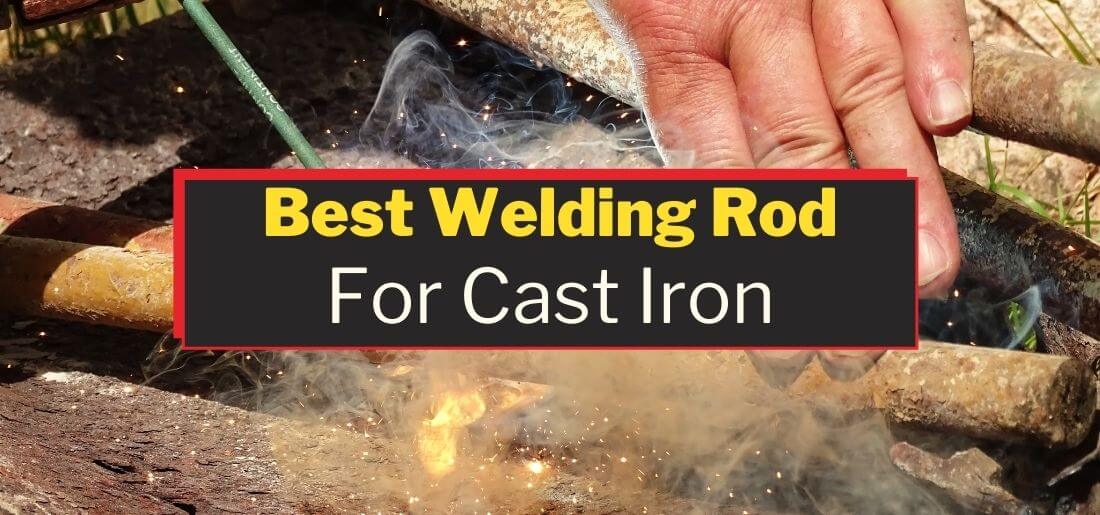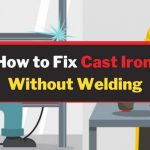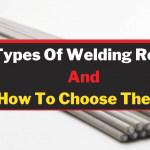Cast iron is brittle and a bit challenging to maintain. But when it comes to its usage, you can see it everywhere, from your workshop to the kitchen.
What if you found a cut, crevice, or crack in a cast-iron piece at your workshop?
Indeed, you will need to fix it, and for that, many welding solutions are available, but the easiest one is to weld it with a welding rod.
Furthermore, to obtain an excellent result, you need to check out the right rod. Without using the best rod, your final result could be underwhelming even when you try your best. To know exactly what kind of welding rod to use on cast iron? You will need to know about the types and best options available in your range.
So, if you are struggling with what kind of welding rod to use on cast iron? Then keep reading. As in this article, we are here to cover all the necessary details to help you select the best welding rods for cast iron.
What Kind Of Welding Rod To Use On Cast Iron?
Many kinds of rods are available for welding cast iron. However, the best rods are machine-able, soft, and have a high amount of copper, nickel, and other metals. The amount of nickel is 55 %, and then the welds are more robust and can tolerate phosphorus formed during the welding process.
There are two common types of rods to weld cast iron discussed below:
1) Nickel Rods
Nickel rods are easy to manage with the help of a nickel-based rod. The two forms of nickel rods are high-level nickel alloy rods and mid-level nickel alloy rods.
- High-level nickel alloy rods contain 90 to 99% pure nickel and are considered one of the best welding rods for cast iron. Also, these rods produce the most long-lasting results and have higher rates as compared to other rods.
- Moreover, nickel alloy rods can get machined and are highly compatible with steel and other low or high-strength metals. Besides, these rods also join cast iron with the least to excessive phosphorus in their makeup.
- Mid-level nickel contains approximately 45% to 60% pure nickel. These rods have a slightly handier build and come with comparable makeup to high-level options. Also, the mid-level nickel alloy rods are best to get wide workpieces a firm joins.
- In addition, you will notice lesser cracks from the post-weld because it has a considerable amount of steel and other alloys. You can perform machine-able and most durable welds with mid-level nickel alloy rods. Besides, the cost of these rods is comparatively lower than high nickel rods.
2) Steel Alloy Rods
The cheapest among all rods for welding is steel electrodes. These rods are suitable for basic repairs rounded off and fillings. A vital advantage of using high steel alloy rods is their friendly characteristic to weld not-so-neat cast iron.
If you want to weld ancient cast iron, the steel alloy can be your best choice for exceptional results.
5 Best Welding Rods for Cast Iron in 2021
1. Hobart 770479 7018 Stick, 1/8-10lbs
🥇 70,000 PSI Tensile Strength
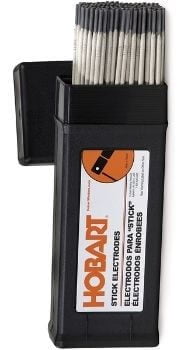
Specifications
- Brand: Hobart
- Material: Plastic
- Size: 1/8-10lbs
- Low hydrogen electrode
- 70,000 PSI tensile strength
- low to high carbonated steel compatibility
One of the best welding rods for cast iron is Hobart 770479 7018 Stick. Hobart provides affordable and durable options. It is a low hydrogen electrode and can be used in all positions. In addition, it is suitable for low to medium and high carbonated steels.
Moreover, it is a convenient option for those welders who are beginners as they burn efficiently. So they are a solid place to start with having a 70 000 TSI tensile strength.
For beginners, it is important to remember that electrode rods are sold in pounds. In addition, we would not recommend these rods for low voltage AC welders. The packaging of this product is not hermetically sealed as it is packaged in plastic.
Pros
Cons
2. Hobart 770460 6011 Stick, 1/8-10lbs
🥇 Reliable Stick Electrodes for Welding
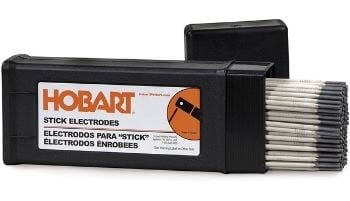
Specifications
- Brand: Hobart
- Material: Plastic
- Size: 3/32-10lbs
- 60,000 PSI tensile strength
- All-purpose rod
- Runs On Ac Or Deep (Reverse) Polarity
If you wonder what kind of welding rod to use on cast iron? Then Hobart 770458 is one of the effective welding rods. It is easier to use by experienced welders as well as beginners. Also, it is helpful in 4 positions, namely vertical, flat, overhead, and horizontal.
Additionally, this whole-purpose welding rod is suitable for galvanized and carbon steel. It is available in the measurement of 3/32 inches, and during a welding process, it can withstand a tensile strength of 60,000 PSI. If you plan to fabricate a small project that needs to be well built, you can go for it.
Furthermore, it is effective for welding dirt, rust, and metals with painted surfaces. Besides, it utilizes DCEP and AC reverse polarity welding devices that smooth the welding progress while increasing productivity.
Pros
Cons
3. Stick Elect, 7018 MR, 1/8 in, 14 L, 10 lb.
🥇 Offer Highest Strength
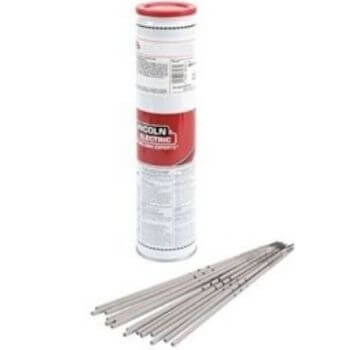
Specifications
- Brand: Lincoln Electric
- Material: Mild steel
- Compatible devices: Hydrogen
- 70 psi Tensile strength
- Container type- Can
- MIG welding installation
One of the most common electrodes in the welding niche for cast iron is the Lincoln electric stick rod. It is the most recommended rod for professionals as it is perfect for repair work, structural steel welding, and heavy pipe welding. It is most compatible with metals and has 70 psi Tensile strength.
Furthermore, the Lincoln electrode is moisture resistant. The rod can be sensitive because it has low hydrogen content. So expose it to air for a minimum and limited time before it becomes defective. However, it can withstand exposure for some time in non-critical and straightforward applications.
Moreover, before using the rod, keep it in the rod oven so that you can preserve the rod and its flux. However, handle it with care while using it. Also, keep it away from humidity and open it when you are ready to burn it. The process of decomposition began with its opening because they are hermetic conserves.
Pros
Cons
4. Forney 31610 E6010 Welding Rod
🥇 All Position Welding Rod with Digging Arc
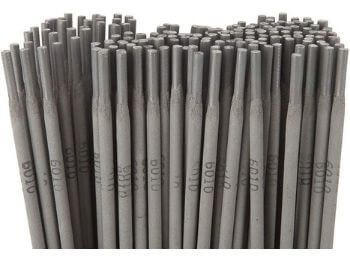
Specifications
- Brand: Forney
- Material: Mild steel
- Size: 1/8-Inch, 10-Pound
- 60,000 Tensile strength
- Arc welding installation
- 90 days warranty
Founded in 1932, Forney offers approximately 5000 products for automotive, farm, hardware, and ranch markets.
Also, they are committed to providing excellent service irrespective of location, size, and needs. Its products are durable and user-friendly rod as Forney industries are one of America’s longest operating companies.
Forney 31610 E6010 Welding Rod can weld through any contaminant because of its high penetration power. It can penetrate through mill scale, rust, and grease, etc. Moreover, it is necessary to prep the metal before welding.
However, Forney 6010 can evenly perform if you do not have time to clean and grid your material.
Moreover, the product has 90 days warranty with proof of verified purchase. However, the warranty does not cover any fault due to neglect, misuse, negligence, or accident. Also, it does not cover any product used in any way opposing the function intended.
Pros
Cons
5. Hobart 770470 6013 Stick
🥇 All-purpose Stick Electrode
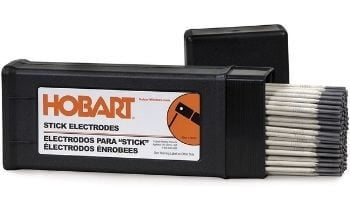
Specifications
- Brand: Hobart
- Material: Plastic
- Size: 1/8-10lbs
- All-purpose stick
- Light to medium penetration power
- 60,000 PSI tensile strength
If you are worried about what kind of welding rod to use on cast iron? You can go for this product as it is best for fabricating projects requiring a lot of strength. This rod is compatible with multiple polarities comprise of Direct current negative, Direct current positive, and Alternative current.
Additionally, Hobart 6013 is similar to 6011 AND 6010 and can penetrate through the galvanized coating and mill scale. Also, it is convenient to work in different positions. Besides, the arc process of the rods is very consistent and smooth, making them suitable for welding metals in irregular positions.
Moreover, it has a soft arc with minimal spatter. It is best for moderate penetration and also easily removes slag. The Hobart 6013 is compatible with different metals, and it works more effectively on clean and thin materials with wide root openings.
Pros
Cons
Things to Consider while Buying Welding Rods for Cast Iron
Choosing the correct type of rod for cast iron might be a bit challenging. However, if you know the work specifications and learn a bit more about what type of rods are compatible with cast iron, you will have no hurdle in selecting the right one.
- Type of Metal
First, it is important to make sure that the cast iron you want to use is weld-able or not. It depends on the graphite form and can appear as rosettes, graphite flakes, or spheroid form. Typically cast iron has carbon content. Usually, it is about ten times more than steel, range from 2% to 4%.
Moreover, due to the presence of carbon, cast iron parts have graphite flakes. It is responsible for the grey color underneath the weld cracks. So before selecting a rod, get to know about the type of metal and the welding method that you are going to use.
- Electrode Properties
Information about electrode properties is necessary to consider before selecting a welding rod for cast iron. The rod that works effectively with cast iron is machine-able, soft and contain high metal level namely nickel and copper. It tends to withstand phosphorous produced during the welding process of cast iron.
Furthermore, the best option for casting with low to medium phosphorous content is an electrode having 99% nickel. This type of electrode produces machine-able welds. However, a more economical option is an electrode that has 55% nickel content. Another option is steel rods as they are more convenient for simple fillers and repairs. Besides, these are user-friendly for arc welding.
- Coating Material
There are eight different types of coatings used on welding rods. The types of coating have a relationship with current, and it determines its compatibility. For example, high Titania potassium and high Titania sodium are compatible with AC.
Furthermore, the high cellulose sodium coating is suitable for DC+ current and has high penetration power. On the other hand, high cellulose potassium welding works with all types of current. So before choosing a rod, have a look at its coating material.
- Size of Welding Rod
During searching, what kind of welding rod to use on cast iron? Notice the thickness of the welding rod. It should meet the size of the metal you work with. Also the amounts the amount of current a welding rod can stand depending on the diameter of the rod.
Moreover, the amperage range is important to consider while selecting a perfect rod for welding cast iron. It is a general assumption that electrodes with low diameter can support a low amount of current or amperage.
- Welding Position
When buying a new rod for welding, consider the welding position. Welding position is the direction in which the driller lays out the welding blob. The best among all is that rods are having all positions welding.
In addition, the four welding positions, which is also considered significant, is horizontal, vertical, flat, and overhead. The welding position is suitable for irregular welding surfaces.
- Tensile strength
According to Santa Rosa Junior College, it is a maximum amount of stress that a material can withstand when pulled or stretch before failing or breaking. The unit of its measurement is pounds per square.
Keep in mind that the minimum tensile strength of the base metal must match with the tensile strength of the rod. It is suitable for avoiding inconsistencies like cracking or breakage. So if you are struggling with durable welding,then consider its tensile strength.
- Current and Polarity
While choosing a welding rod, check its polarity. Good popularity ensures a consistent and robust weld. Four ordinary poles are AC+, AC-, DC+, and DC-. Notice that the rod you are choosing works with AC or DC.
Additionally, you can go for 6020 electrodes if you want DC and is suitable for maintenance work. Some electrodes work with both AC and DC. You may also search by simply typing “DC or AC welding rods”.
FAQs about Cast Iron Welding
1) How Best To Weld Cast Iron?
Cast iron crack easily because of thermal stress due to its poor ductility. It also breaks when rapidly cooled or healed. But the susceptibility of breakage also depends on the type of cast iron. For welding cast iron, you have to follow proper steps.
First, it is important to clean the cast iron by removing surface dirt and materials like paint and oil. 2nd important thing is proper heating, and the last is post welding heating. Do not cool down cast iron rapidly as it will lead to cracking.
2) Can You Weld Cast Iron With Low Hydrogen Rods?
Yes, you can weld cast iron with low hydrogen by using MMA. It is done using low hydrogen electrodes and low carbon steels at low currents. It gives satisfactory welds in malleable iron. While using the low carbon steel electrode, annealed the part to reduce hardness in the weld.
The MMA welding is also called shielded metal arc welding. It is the best process for welding cast iron when done with correct welding rods. The choice of electrode depends on the required color match, amount of post-weld machining, and type of electrode. However, the standard type of electrode for manual arc welding is nickel and iron-based.
3) What Are The Main Fillers For Welding Cast Iron With A Stick Welder?
There are mainly three types of fillers for welding cast iron with stick welders. These are copper alloy electrodes, cast iron-covered electrodes, and copper alloy electrodes. The most popular among them for cast iron welding is nickel alloy electrode.
New Hampshire Materials Laboratory Inc. states that nickel-iron weld is firm with a minor coefficient of thermal expansion, dropping welding stresses while improving resistance to cracking.
4) Can You Weld Cast Iron With 6011 Rods?
Yes, you can weld cast iron with 6011 rods. While the best trick is using 6011 rods pre and post-heal the steel. Heat the cast iron which you are going to weld, then weld it and grind it. Then let it cool a bit and again heat it.
Repeat the same procedure 3- 4 times for slowly cooling of cast iron. Moreover, it has high tensile strength and suitable for carbon and galvanized steel. You can choose it for welding small fabricated projects.
5) Can Cast Iron Be Welded With 7018?
Cast iron can be welded in different ways, and one of them is with 7018 rods. The welding of the 7018 rods is not drillable but hard. For welding cast iron with 7018, preheat, peen, and then cool down it slowly to avoid cracking.
It is relatively cheaper than other rods. If you are a beginner, then you can go for it as it is easy to use. Also, it has the ability to weld surfaces covered with dirt or paint.
Conclusion
In short, welding cast iron is not accessible due to its carbon content, and it is prone to cracking. While welding a cast iron with the rod, select a rod with properties related to casting iron. So if you are searching for the best welding rods,you can rely on the rods reviewed above.
In addition, we have reviewed the five best welding rods for fixing cracked cast iron. If you have just started arc welding and are looking for a versatile and durable rod, go for Hobart 770479 7018 Stick, Forney 31610 E6010 Welding Rod and Stick Elect 7018 MR.
These rods do not produce that much splatter and are compatible with AC and DC currents. The welds done by these rods are resistant to moisture damage and can withstand welding in cold regions. Hopefully, this article will be helpful for you in buying the most suitable rod for welding cast iron.
